The 2021 NWSL season provided us with many surprises, but none more so than Washington Spirit finishing as league champions, defeating Chicago Red Stars in the Championship (the name given to the play-off final). Many expected either Portland Thorns or OL Reign to lift the title, as both had been near the summit for most of the campaign and had the strongest squads on paper. However, both tailed off in form as the season neared its conclusion, allowing other teams to come in and stake their claims to be champions.
What made it even more special was that it was Washington’s first-ever NWSL title. The only other time they had come close to being champions was in 2016 when they finished as runners-up to Western New York Flash, who have since been disbanded. This tactical analysis will look in detail at the Spirit’s defence, midfield and attack, picking out the tactics that helped them to reach the top of American women’s domestic football.
Attack
The first thing to focus on is Washington Spirit’s attack, in particular, identifying a couple of their key players in this area of the field.
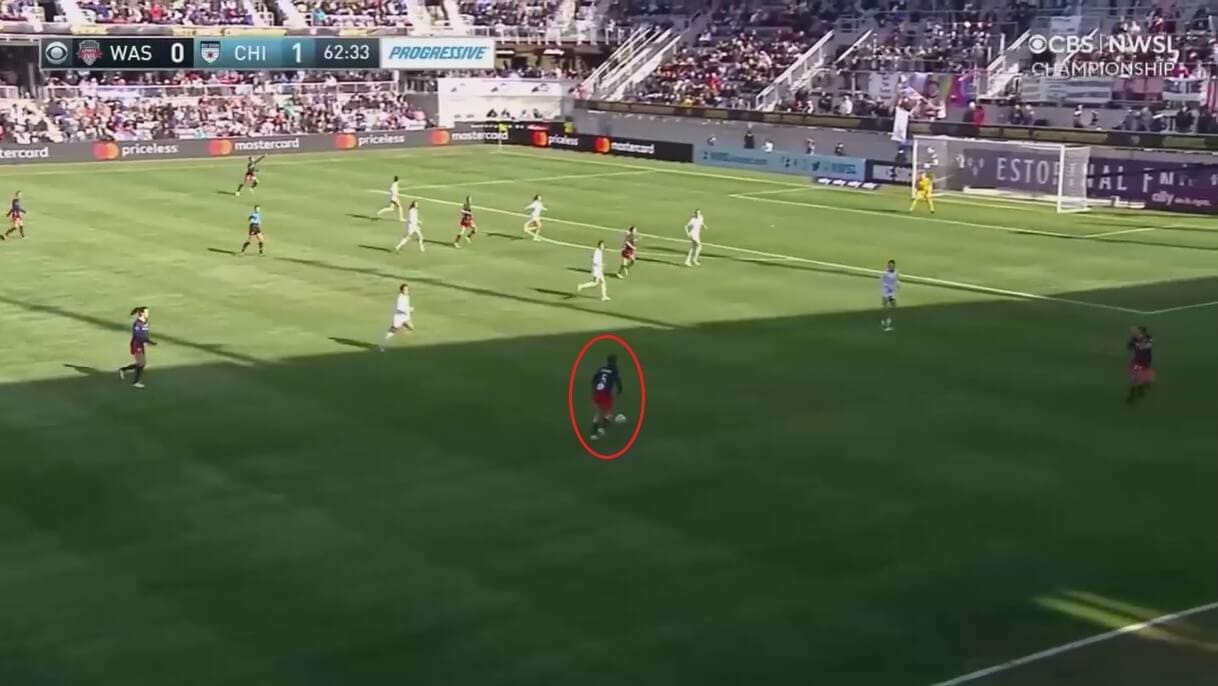
It became a regular sight in Washington’s games to see players pushing up the field to help overload the opposing goal area. Defenders playing high up the pitch, positioning themselves around the halfway line, enabled them to do this. This gave the Spirit the option of passing back to the centre-backs when they couldn’t find a way through the opposing defence, which helped them to keep building attacks.
The full-backs got even further forward than the centre-backs, as shown in this image, with USA right-back Kelley O’Hara getting into a dangerous area and looking for a pass into the box. Her advance allowed the midfielders to get higher up the pitch as well, increasing the number of players that O’Hara can aim for. This made it harder for Chicago Red Stars, who had been forced to backpedal towards their own goal, to predict where the ball would go. Getting into these positions is a key feature of O’Hara’s individual game, so this is one thing that Washington undoubtedly benefitted from during the campaign.
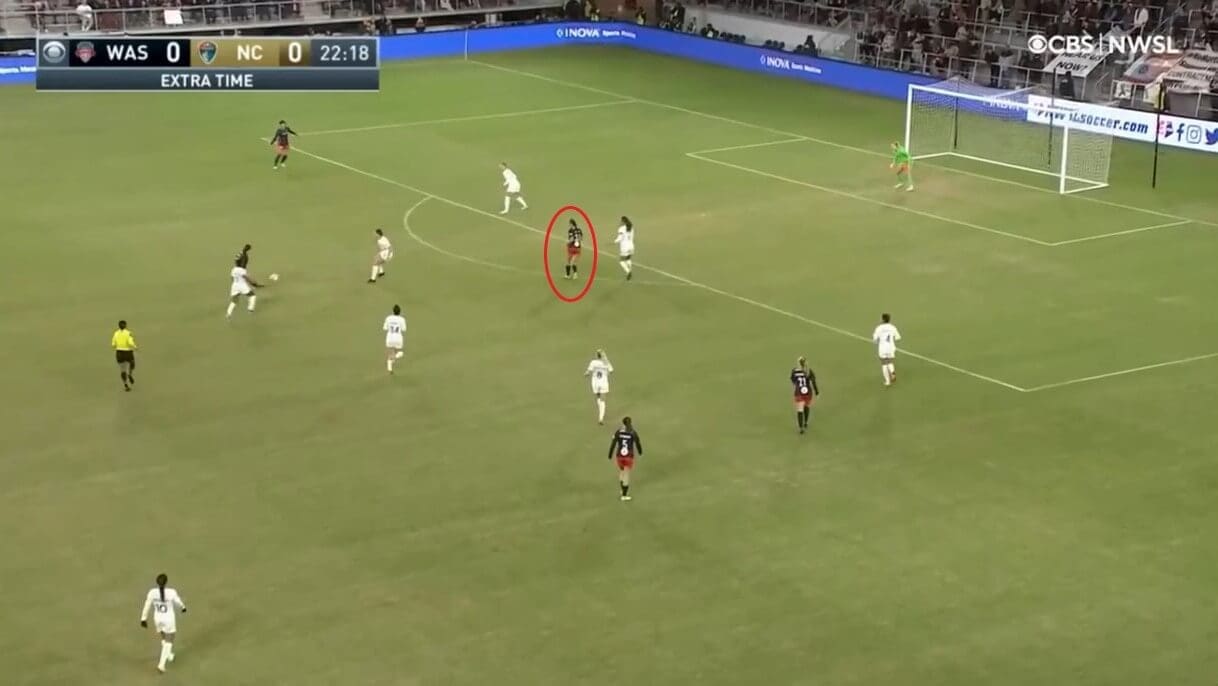
A major reason for Washington carrying such a threat in attack was the profile of forwards they have in their squad. Here, we see Ashley Hatch on the edge of the North Carolina Courage goal area, making herself available to either receive a pass or make a run into the box. North Carolina were another team that suffered a drop in form as the season went on, eventually sealing their place in the play-offs on the final day of the regular season, so Washington knew that they would have plenty of opportunities to get behind them.
Hatch is the type of striker who leads the line, acting as a poacher when there are loose balls in the box, and this situation shows the build-up to the goal that took Washington into the play-off semi-finals. Hatch finished as the league’s top scorer in 2021 with 10 goals to her name, while Washington scored 1.28 times per game throughout the season, both of which highlight how Hatch’s presence on the pitch caused opposing defenders problems, and her inclusion undoubtedly gave Washington an advantage in attacking situations.
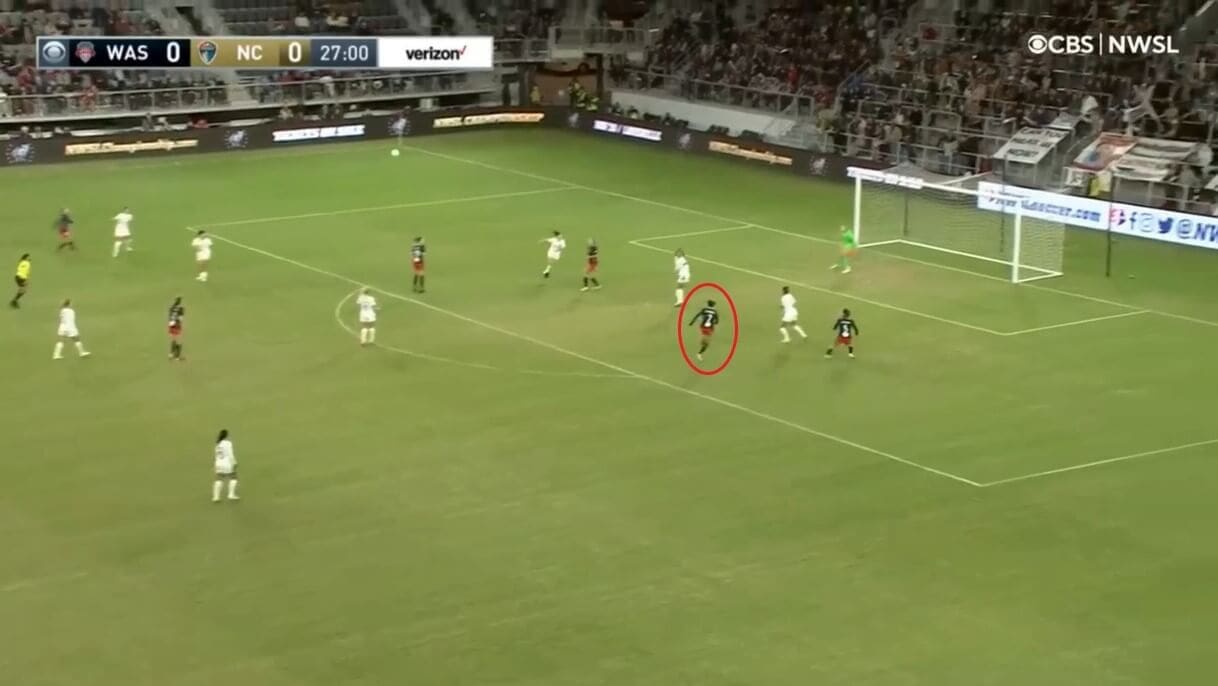
Their other key attacking player is Trinity Rodman, who was generally seen in a freer role than Hatch, moving around the pitch and getting into areas where she could affect the game. She was the player who made runs that opponents weren’t expecting, timing her movements well to ensure that they had as little time to react as possible. Here, North Carolina have left a small gap open through the middle, which is all Rodman needed to create a passing option in the space behind.
The fact that she was named as the NWSL’s Top Rookie for 2021 is no surprise because she was the one who gave Washington a spark when they needed some creativity. This was especially important in the NWSL Championship, as Chicago took the lead in that game, and Washington needed to add a little more creativity to their play; Rodman gave them that and was a key reason for them turning the match around to win the game.
Washington may have only got 36.4% of their shots on target last season but with Hatch and Rodman on the field, they had a good balance in the final third, and that was a key factor in them securing the NWSL title.
Midfield
Perhaps the most important area of the Washington Spirit team is the midfield, as it was in the central third where many of their attacks began. This was another area where they had a good shape that made them difficult to beat.
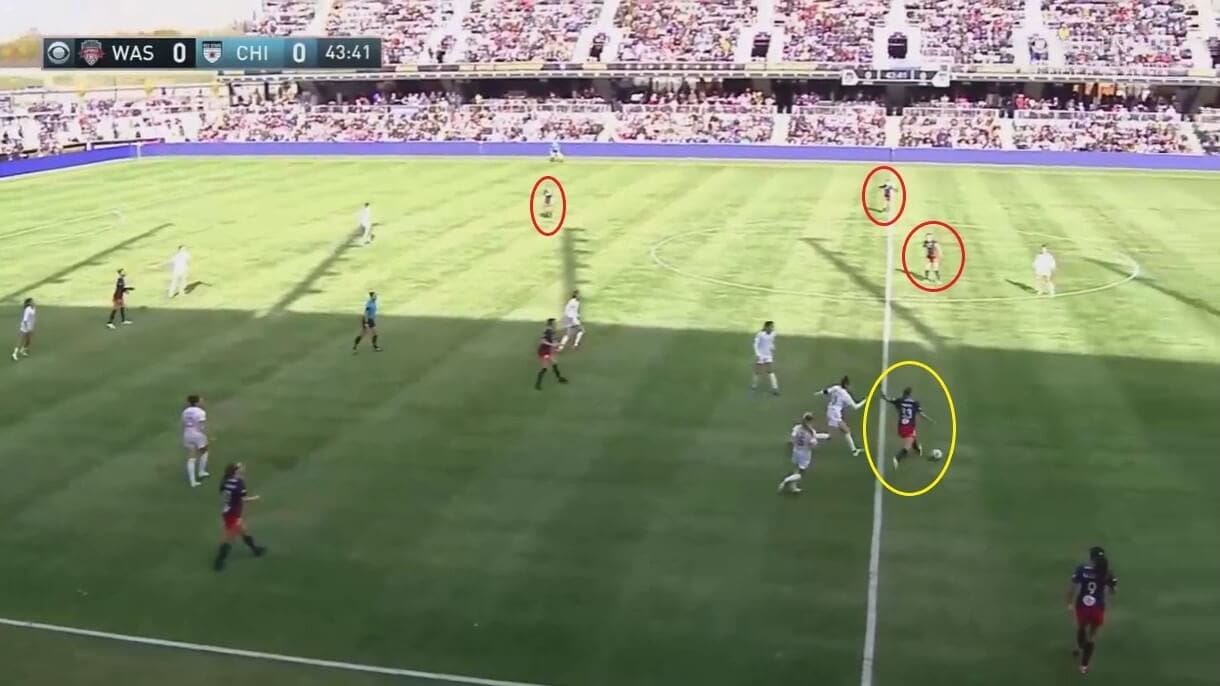
Something that Washington like to do a lot of is to stretch the play and make the pitch as big as possible. It was common to see them passing around the pitch and being patient, waiting for the right opportunity to break through the opposing defence. As a result, opposing teams were generally forced to come out and try to win the ball off them, as Chicago have looked to do here.
However, this is what Washington wanted to happen, and they never panicked when under this kind of pressure. Instead, they waited until the defenders had committed to whichever player had possession, before releasing the ball into another area of the pitch. This is where the other players come into the picture, as there are three options available for the passer here. By taking up these positions, these three players not only made the pitch as big as possible but also ensured that Washington could keep building their attack from another area of the pitch now that their initial line had been closed off.
The Spirit had a passing accuracy of 80.8% and an average possession per game of 52.29% last season, which shows how keeping the ball is one of their strengths, and it is helped once again by the full-backs getting forward to offer support, allowing them to use these open spaces to their advantage. Therefore, their spatial awareness as a team was an essential part of their title success, and it was in the midfield where this was demonstrated most.
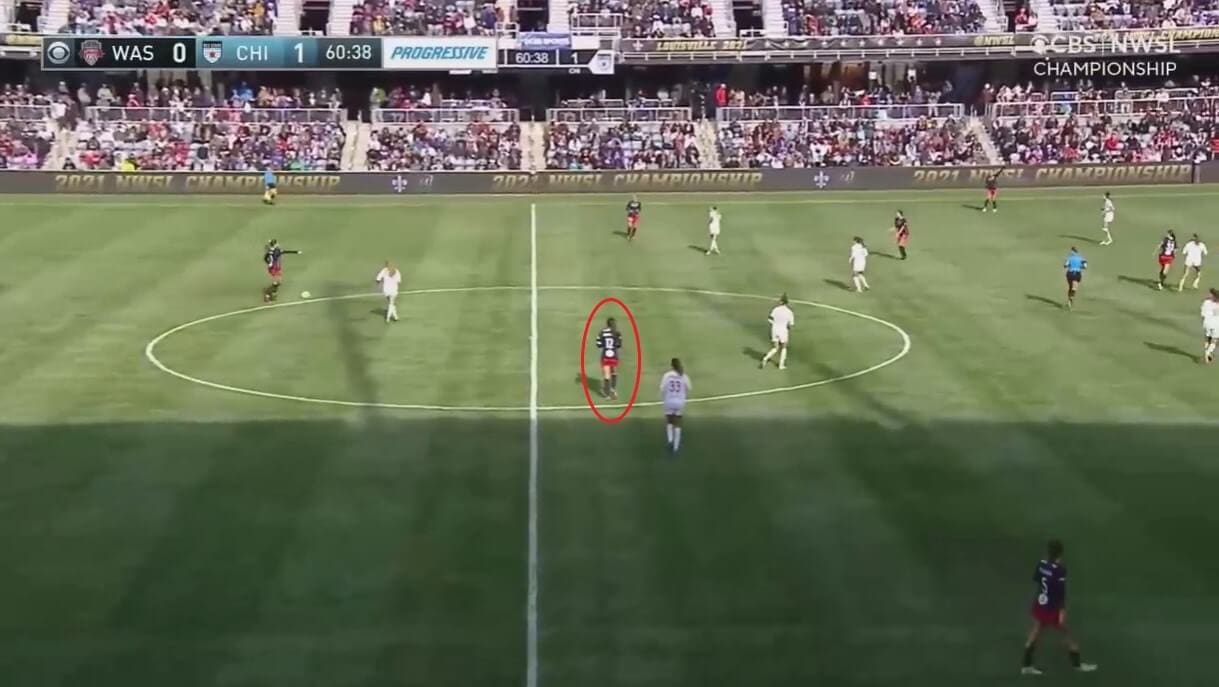
If we continue with our list of players who proved to be irreplaceable for Washington last season, then their captain, Andi Sullivan, definitely needs a mention. Washington mainly operated with a 4-2-3-1 or 4-3-3 formation last season (using them on 52% and 24% of occasions respectively), with Dorian Bailey and Sullivan usually in the two midfield roles or playing as two parts of their three-player midfield line, and this individual versatility gave Washington variation in the way they were able to set up their central players. Whilst Bailey had a mostly defensive role, Sullivan was free to move around the pitch and help out at both ends, and she did a lot of the unseen work that allowed Washington’s transitional play to flow as a result, including finding pockets of space which gave opposing defenders something else to think about.
Washington last season had a 62.5% accuracy for passes into the final third, which was largely due to Sullivan’s calm nature in the middle, picking out teammates and helping to launch attacks. Often in these situations, she didn’t actually receive the ball, but her presence and ability to provide an option meant that the defenders had to keep concentrating on her, meaning that they weren’t necessarily focusing on where the ball was going.
Sullivan was also hugely important in their link-up play. The Spirit’s aforementioned midfield balance and the fact that the midfielders and attackers tended to operate close to one another meant that they could play their way out of tight spaces, and Sullivan was usually involved in these passages of play. As with the previous image, being able to go from controlled passing to quick ball movement enabled Washington to keep their attacks alive, even when it looked as if they would need to pass backwards and rebuild.
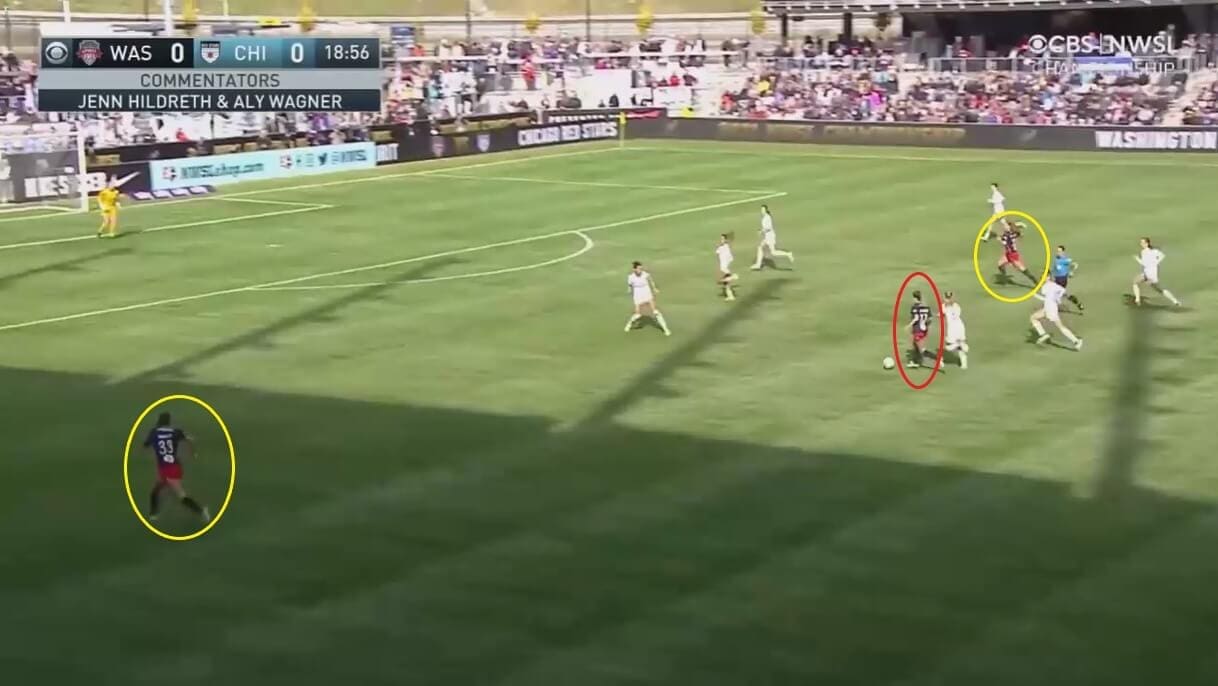
Whilst Sullivan’s role was mainly to help move the ball through the midfield third, Ashley Sanchez, the third part of Washington’s regular midfield trio, was the attacking presence behind the striker. She brought the ability to hold onto the ball for as long as possible to the team, forcing opponents to commit to her and leave the other Washington players open and available as a passing option. Here, Chicago’s defence has become narrow in the middle, with Washington having players ready and ahead of the ball due to their aforementioned ability to stretch the play, allowing them to turn this attack into a potential shot on goal.
Sanchez was the main source of creativity in Washington’s attacking play, and her partnership with Ashley Hatch was a key strength for the Spirit. When opposing teams looked defensively organised, Sanchez was the one that Kris Ward’s side relied on to break them down and find Hatch (or Rodman, for that matter) in the space behind, ensuring that Washington could break teams down and win games. This was particularly notable in the game against North Carolina earlier in the season, as the Courage sought to keep the Spirit out and get a result, which was vitally important for them at that stage. However, when they left gaps open, Sanchez made incisive passes to expose their defensive mistakes, so her inclusion in the team was another reason that the team went on to take the NWSL title last season.
Defence
Washington Spirit’s defensive play throughout the season was equally impressive, which came down largely to their organisation and teamwork at the back, as the next section of this analysis will show.
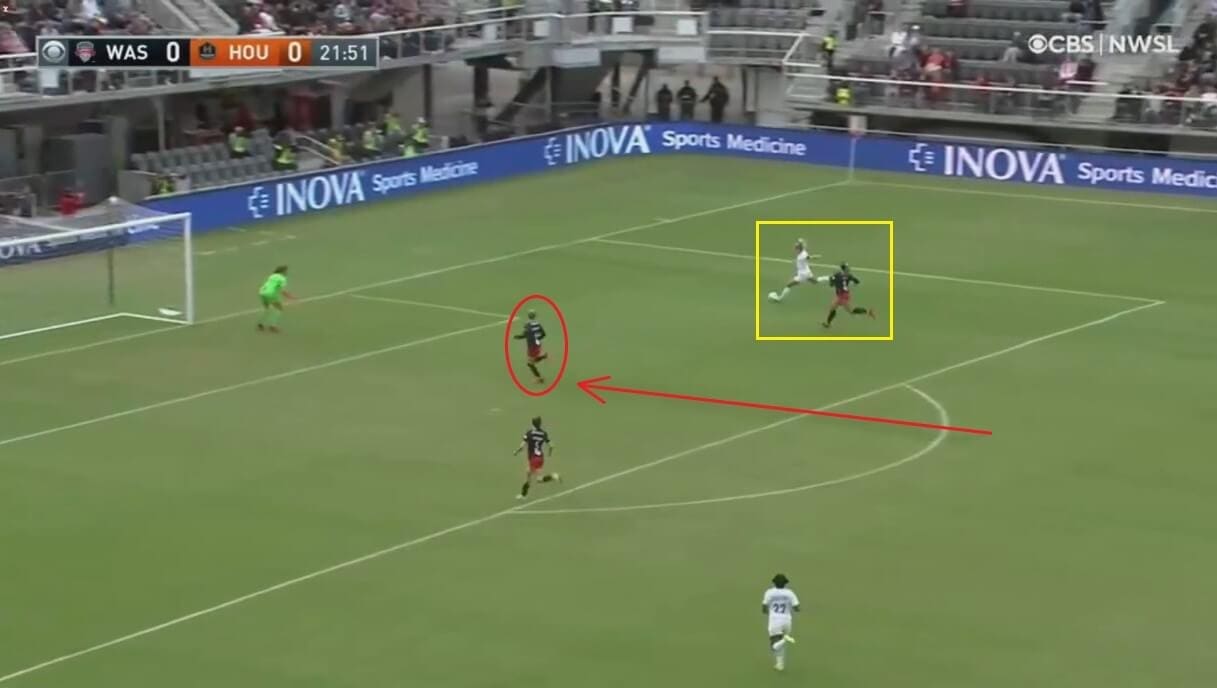
Here, Houston Dash and England forward Rachel Daly has made a run towards the Washington goal area with two defenders running alongside her, trying to close her down. We need to focus on the running angle of the inside defender, Emily Sonnett. Whilst her teammate got tight to Daly and looked to win the ball, Sonnett kept her distance and instead moved into a position in the middle of the box, as the red arrow shows.
This limited Daly’s options, as she couldn’t now pull the ball back for fellow forward Jasmyne Spencer, who is at the bottom of the screen, as Spencer would have needed to beat two defenders to shoot at goal, so it would have been difficult for her to make anything of this opportunity. Whilst Daly would have likely taken the shot anyway, such was her form and confidence last season, Washington’s clever defensive positioning forced her into taking this option, and the tight angle meant that there was more chance of her missing the target, which was what happened. Therefore, Sonnett played a crucial role in ending this attack and given the threat posed by Houston in the latter stages of the season, small details like this were crucial to the Spirit being hard to beat in their own third.
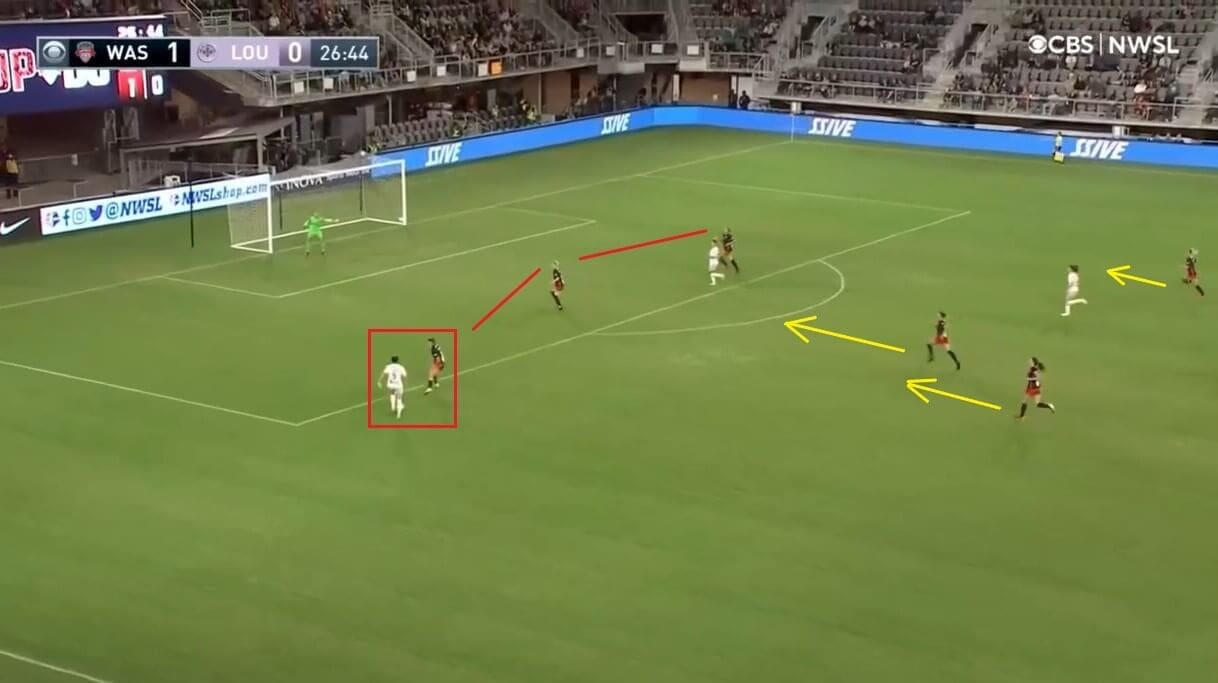
The other thing that Washington were very good at was closing players down and forcing them to end their attacks prematurely. On this occasion, Racing Louisville have got themselves up to the edge of the box, looking to create a goalscoring opportunity, with Washington caught out by the speed of their attack. As a result, there were only three defenders between the ball and the goal. However, their organisation and teamwork came into play here, as the defender nearest the Louisville player in possession got tight to them, which gave the other Washington players time to get back and set up to cut off any gaps.
Having multiple defensive lines was a common sight in Washington’s games, and their meeting with NJ/NY Gotham saw them needing to defend compactly to prevent the attackers from finding a way through. Gotham had different threats in their side, including versatile defender Caprice Dydasco, who registered the joint-second-most assists last season, and forwards Midge Purce, Ifeoma Onumonu and the now-retired Carli Lloyd, who provided constant problems. Therefore, having the ability to set up in a way that kept these threats out was another reason that Washington became NWSL winners for the first time in their history.
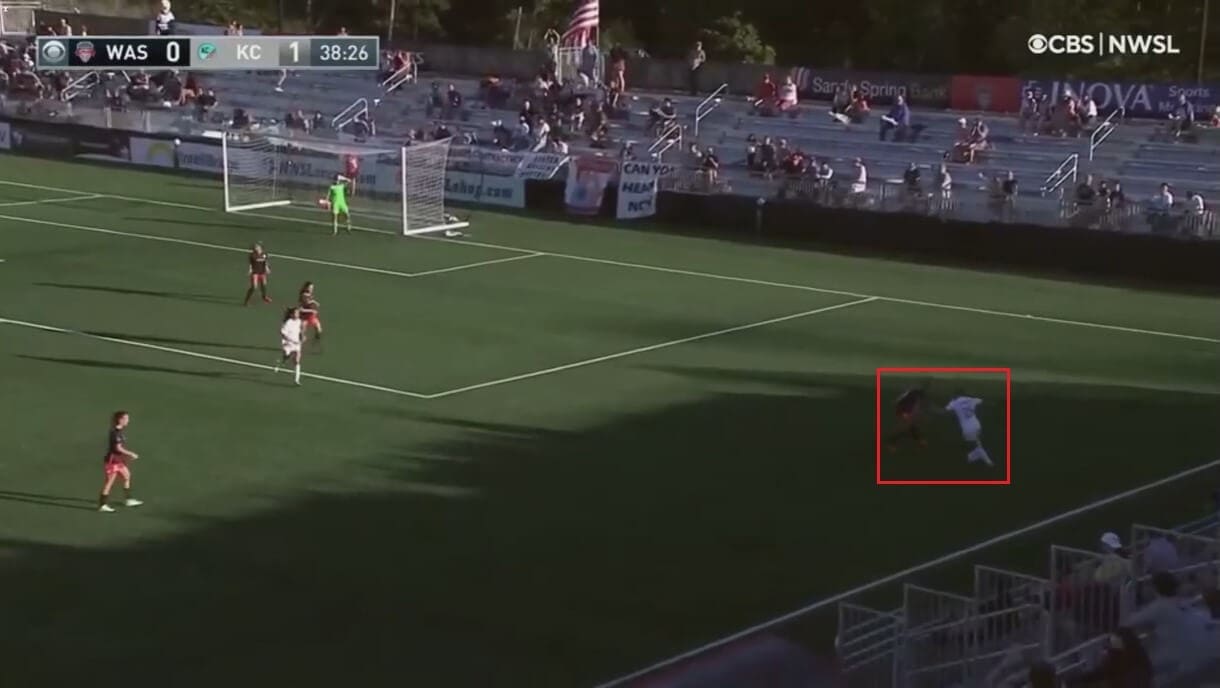
This image shows another example of when Washington got tight to their opponents, this time against Kansas City (now known as Kansas City Current). Kansas were the league’s other strugglers last season but showed some good form after the mid-season arrival of forward Kristen Hamilton from North Carolina. She was a player who asked questions of opponents and had a good range of passing, as well as a knack for finding teammates behind opposing defences.
As Washington were unable to dominate in their own third against them, they had to ensure that their key threats weren’t able to link up, and this is where their ability to close opponents down once more came into play. They won 61.7% of their defensive duels last season, which helped to slow down opponents and limit their passing options in the Spirit’s third. So, even when they seemed to be struggling, they had a good defensive attitude and were tough to break down.
Conclusion
In conclusion, we have looked in this scout report at the tactics used by Washington Spirit in their 2021 title-winning campaign, which was a huge achievement for them and one that not many fans saw coming. They have had many excellent players on their books in the past, including Manchester City Women and former Everton Women forward Hayley Raso from Australia and Tottenham Hotspur Women’s Canadian defender Shelina Zadorsky, but their current group of players’ team ethic has been the key to their strong performances, and that was what helped them to be so successful.
Whilst Portland and OL will undoubtedly, once again, be among the favourites for the 2022 title, the points raised in this article have shown that, with some good recruitment in the close season, Washington will also be up there and cannot be counted out of another potential title fight.




Comments